The AMD Zen and Ryzen 7 Review: A Deep Dive on 1800X, 1700X and 1700
by Ian Cutress on March 2, 2017 9:00 AM ESTBenchmarking Performance: CPU System Tests
Our first set of tests is our general system tests. These set of tests are meant to emulate more about what people usually do on a system, like opening large files or processing small stacks of data. This is a bit different to our office testing, which uses more industry standard benchmarks, and a few of the benchmarks here are relatively new and different.
PDF Opening
First up is a self-penned test using a monstrous PDF we once received in advance of attending an event. While the PDF was only a single page, it had so many high-quality layers embedded it was taking north of 15 seconds to open and to gain control on the mid-range notebook I was using at the time. This put it as a great candidate for our 'let's open an obnoxious PDF' test. Here we use Adobe Reader DC, and disable all the update functionality within. The benchmark sets the screen to 1080p, opens the PDF to in fit-to-screen mode, and measures the time from sending the command to open the PDF until it is fully displayed and the user can take control of the software again. The test is repeated ten times, and the average time taken. Results are in milliseconds.
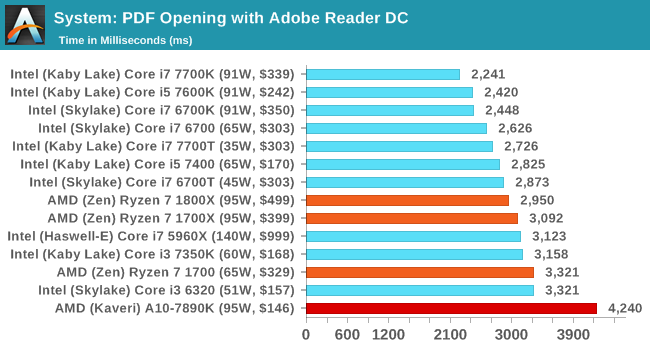
FCAT Processing
One of the more interesting workloads that has crossed our desks in recent quarters is FCAT - the tool we use to measure stuttering in gaming due to dropped or runt frames. The FCAT process requires enabling a color-based overlay onto a game, recording the gameplay, and then parsing the video file through the analysis software. The software is mostly single-threaded, however because the video is basically in a raw format, the file size is large and requires moving a lot of data around. For our test, we take a 90-second clip of the Rise of the Tomb Raider benchmark running on a GTX 980 Ti at 1440p, which comes in around 21 GB, and measure the time it takes to process through the visual analysis tool.
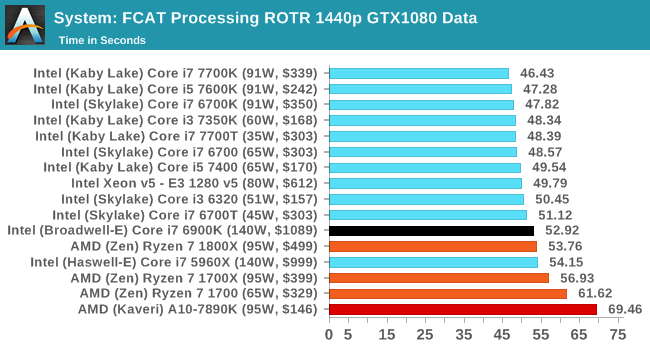
3D Particle Movement v2.1
This is the latest version of the self-penned 3DPM benchmark. The goal of 3DPM is to simulate semi-optimized scientific algorithms taken directly from my doctorate thesis. Version 2.1 improves over 2.0 by passing the main particle structs by reference rather than by value, and decreasing the amount of double->float->double recasts the compiler was adding in. It affords a ~25% speed-up over v2.0, which means new data.
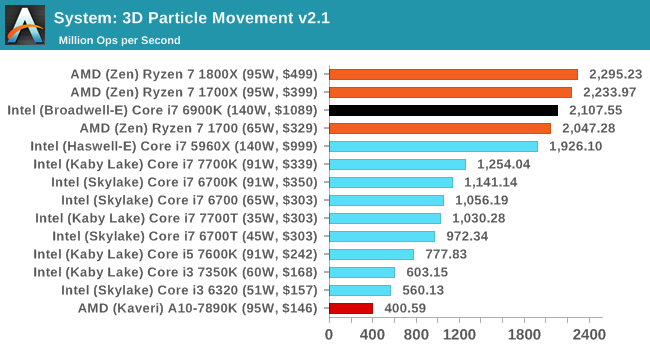
DigiCortex 1.16
Despite being a couple of years old, the DigiCortex software is a pet project for the visualization of neuron and synapse activity in the brain. The software comes with a variety of benchmark modes, and we take the small benchmark which runs a 32k neuron/1.8B synapse simulation. The results on the output are given as a fraction of whether the system can simulate in real-time, so anything above a value of one is suitable for real-time work. The benchmark offers a 'no firing synapse' mode, which in essence detects DRAM and bus speed, however we take the firing mode which adds CPU work with every firing.
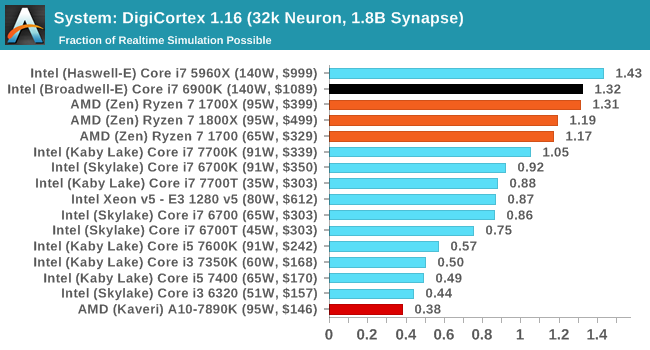
Agisoft Photoscan 1.0
Photoscan stays in our benchmark suite from the previous version, however now we are running on Windows 10 so features such as Speed Shift on the latest processors come into play. The concept of Photoscan is translating many 2D images into a 3D model - so the more detailed the images, and the more you have, the better the model. The algorithm has four stages, some single threaded and some multi-threaded, along with some cache/memory dependency in there as well. For some of the more variable threaded workload, features such as Speed Shift and XFR will be able to take advantage of CPU stalls or downtime, giving sizeable speedups on newer microarchitectures.

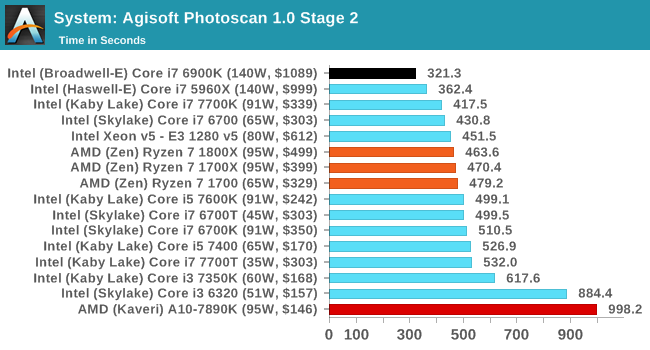
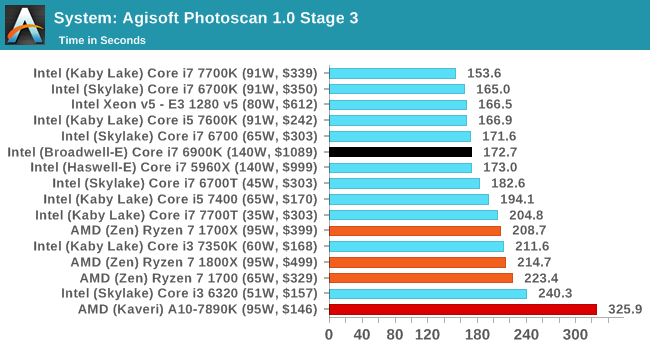
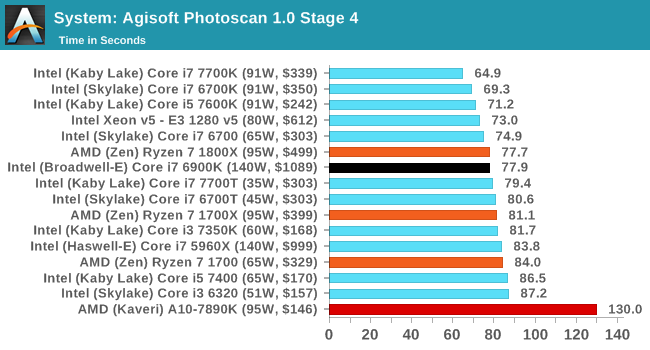
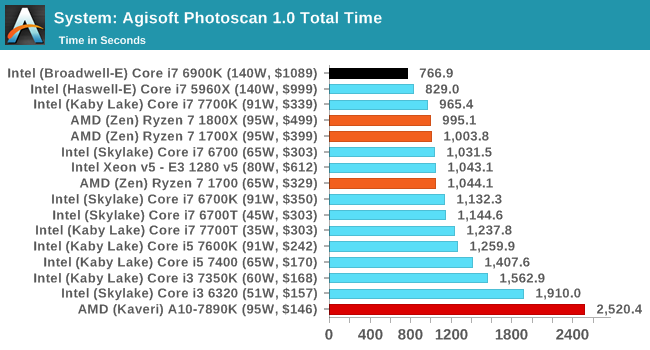










574 Comments
View All Comments
Cooe - Sunday, February 28, 2021 - link
Find me these so-called people buying Intel HEDT CPU's (aka OG Ryzen 7's direct competition) for gaming & never for HPC uses.... Oh wait. They don't exist.Haawser - Thursday, March 2, 2017 - link
Yeah, but if you're a gamer who streams, Ryzen is waaaay better than anything Inter offer for $499. Especially if you're gaming at 4K, or going to be. Different people have different needs, even gamers.Jimster480 - Thursday, March 2, 2017 - link
Yes but no,Because Broadwell-E and Haswell-E HEDT platforms are in the same boat as Ryzen.
But this is what this Ryzen 7 release is meant to do.
Compete with the HEDT platforms, not against the "APU" chips.
Those chips will come later, albeit with much higher clockspeeds to compete with intel.
For now you have Intel with 10-20% clockspeed advantages in clockspeed dependent applications.
Meteor2 - Saturday, March 4, 2017 - link
I hope you're right but there's no indication they will be clocked higher. AMD has access to processes which are generation behind Intel's, at least for a couple of years. We can't expect miracles.nos024 - Thursday, March 2, 2017 - link
Lol, butt hurt? Why even bother running gaming benchmarks? You even said it yourself that ryzen wont make it to your so called grown-up workstation because if low pcie count.So tell me who is this $500 Ryzen chip designed for? Not grown ups running workstation, or pathetic kiddies gamers...so theyre for Wannabes?
Tunnah - Thursday, March 2, 2017 - link
He literally said it is ideal to replace his aging 3770k, he gave an example of how it will be used. Try more reading and less being a turdddriver - Thursday, March 2, 2017 - link
Ryzen is that much more affordable that with the price difference I could have built another whole system, dedicated to running the 2 HBA adapters, thus saving on the need of 16 lanes. 40 - 16 is exactly 24, which is what ryzen has. If it was available a year ago I would have simply built two systems, offering a good 50-60% more CPU performance, double the GPU performance, with enough need to accommodate my IO needs, even if between two systems, that wouldn't have been much of an issue.The pci lane count is lower than intel E series chips, however it is still 50% higher than what you can get from intel outside the E series. It will actually suffice in most workstation scenarios, even if you end up running graphics at x8, which is not really a big deal.
ddriver - Thursday, March 2, 2017 - link
"you even said it yourself that ryzen wont make it to your so called grown-up workstation because if low pcie count"I did not say that. Not all workstations require 40 pcie lanes. Most could do with 24. I was talking about my workstation in particular, which has plenty of pcie hardware. For the vast majority of HPC scenarios that would not be necessary, furthermore as already mentioned, with the saved money you can build additional systems dedicated to specific tasks, offloading both the need of more pcie lanes and the cpu time the attached hardware consumes.
It remains to be seen how much IO will the server zen parts have. Ryzen is not particularly a workstation grade chip, it just happens to be GOOD ENOUGH to do the job. AMD give you 50% more performance and 50% more IO at the same or better price point, and I think they will do the same for the chips they actually design for workstation.
It looks like the 16 core workstation chip will have 64 pcie lanes, and the 32 core - a whooping 128 lanes. So intel E series looks like a sad little orphan with its modest 40 lanes... And no, xeons aren't much better, they are in fact worse, the 24 core E7-8894 v4 only has a modest 32 lanes.
So no, while I will not be replacing my main 10 core workstation with a ryzen, because that would win me nothing, I am definitely looking forward to replacing it next year with a Naples system, and I definitely wished ryzen was available last year as I could have spent my money much better than buying intel.
Intel999 - Thursday, March 2, 2017 - link
"So tell me who is this $500 Ryzen chip designed for?"Logic would imply it is aimed at anyone that works in an environment where they need superior multithreading performance. For instance, anyone that has bought a 6900k or 6950k, but more importantly it is for those individuals that "wanted" to buy either of Intel's multi core champs but couldn't due to ridiculous prices.
I'd dare to make a bet there are more people that wanted to buy a 6900k than there are people that actually did. Now they can buy one and still put food on the table this month.
FriendlyUser - Thursday, March 2, 2017 - link
Exactly right. I was always tempted by the 6850K, but the price of the CPU+platform was simply ridiculous. For much less I got a faster CPU and a high-end MB. I won't miss the 40PCIe lanes.